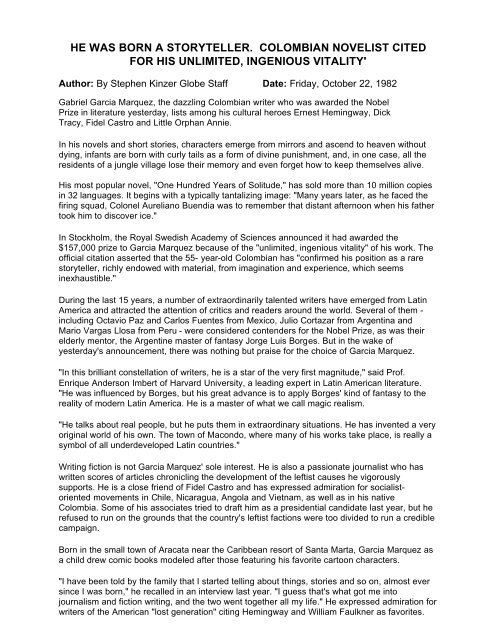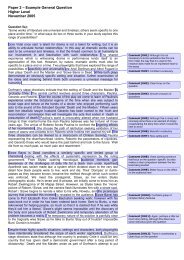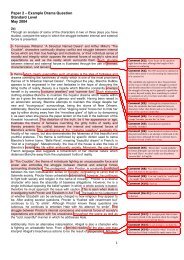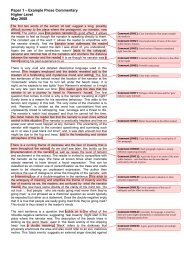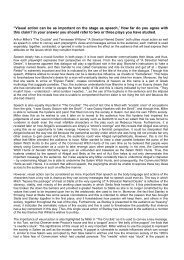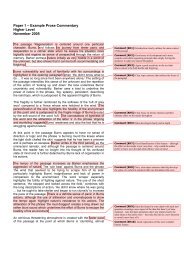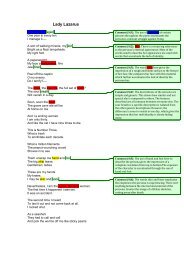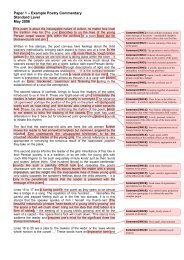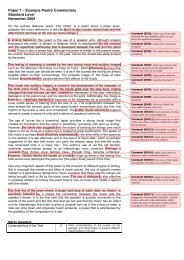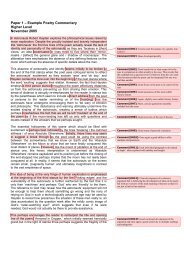A Born Storyteller - Mr Hoye's IB English Website
A Born Storyteller - Mr Hoye's IB English Website
A Born Storyteller - Mr Hoye's IB English Website
- No tags were found...
You also want an ePaper? Increase the reach of your titles
YUMPU automatically turns print PDFs into web optimized ePapers that Google loves.
HE WAS BORN A STORYTELLER. COLOMBIAN NOVELIST CITEDFOR HIS UNLIMITED, INGENIOUS VITALITY'Author: By Stephen Kinzer Globe Staff Date: Friday, October 22, 1982Gabriel Garcia Marquez, the dazzling Colombian writer who was awarded the NobelPrize in literature yesterday, lists among his cultural heroes Ernest Hemingway, DickTracy, Fidel Castro and Little Orphan Annie.In his novels and short stories, characters emerge from mirrors and ascend to heaven withoutdying, infants are born with curly tails as a form of divine punishment, and, in one case, all theresidents of a jungle village lose their memory and even forget how to keep themselves alive.His most popular novel, "One Hundred Years of Solitude," has sold more than 10 million copiesin 32 languages. It begins with a typically tantalizing image: "Many years later, as he faced thefiring squad, Colonel Aureliano Buendia was to remember that distant afternoon when his fathertook him to discover ice."In Stockholm, the Royal Swedish Academy of Sciences announced it had awarded the$157,000 prize to Garcia Marquez because of the "unlimited, ingenious vitality" of his work. Theofficial citation asserted that the 55- year-old Colombian has "confirmed his position as a rarestoryteller, richly endowed with material, from imagination and experience, which seemsinexhaustible."During the last 15 years, a number of extraordinarily talented writers have emerged from LatinAmerica and attracted the attention of critics and readers around the world. Several of them -including Octavio Paz and Carlos Fuentes from Mexico, Julio Cortazar from Argentina andMario Vargas Llosa from Peru - were considered contenders for the Nobel Prize, as was theirelderly mentor, the Argentine master of fantasy Jorge Luis Borges. But in the wake ofyesterday's announcement, there was nothing but praise for the choice of Garcia Marquez."In this brilliant constellation of writers, he is a star of the very first magnitude," said Prof.Enrique Anderson Imbert of Harvard University, a leading expert in Latin American literature."He was influenced by Borges, but his great advance is to apply Borges' kind of fantasy to thereality of modern Latin America. He is a master of what we call magic realism."He talks about real people, but he puts them in extraordinary situations. He has invented a veryoriginal world of his own. The town of Macondo, where many of his works take place, is really asymbol of all underdeveloped Latin countries."Writing fiction is not Garcia Marquez' sole interest. He is also a passionate journalist who haswritten scores of articles chronicling the development of the leftist causes he vigorouslysupports. He is a close friend of Fidel Castro and has expressed admiration for socialistorientedmovements in Chile, Nicaragua, Angola and Vietnam, as well as in his nativeColombia. Some of his associates tried to draft him as a presidential candidate last year, but herefused to run on the grounds that the country's leftist factions were too divided to run a crediblecampaign.<strong>Born</strong> in the small town of Aracata near the Caribbean resort of Santa Marta, Garcia Marquez asa child drew comic books modeled after those featuring his favorite cartoon characters."I have been told by the family that I started telling about things, stories and so on, almost eversince I was born," he recalled in an interview last year. "I guess that's what got me intojournalism and fiction writing, and the two went together all my life." He expressed admiration forwriters of the American "lost generation" citing Hemingway and William Faulkner as favorites.
without attacking the crumbling walls of reinforced stone, as the more resolute had wished,and without using oxbows to knock the main door off its hinges, as others had proposed,because all that was needed was for someone to give a push and the great armored doorsthat had resisted the lombards of William Dampier during the building's heroic days gaveway. It was like entering the atmosphere of another age, because the air was thinner in therubble pits of the vast lair of power, and the silence was more ancient, and things werehard to see in the decrepit light. All across the first courtyard, where the paving stones hadgiven way to the underground thrust of weeds, we saw the disorder of the post of the guardwho had fled, the weapons abandoned in their racks, the big, long rough-planked tableswith plates containing the leftovers of the Sunday lunch that had been interrupted by panic,in shadows we saw the annex where government house had been, colored fungi and paleirises among the unresolved briefs whose normal course had been slower than the pace ofthe dryest of lives, in the center of the courtyard we saw the baptismal font where morethan five generations had been christened with martial sacraments, in the rear we saw theancient viceregal stable which had been transformed into a coach house, and among thecamellias and butterflies we saw the berlin from stirring days, the wagon from the time ofthe plague, the coach from the year of the comet, the hearse from progress in order, thesleep-walking limousine of the first century of peace, all in good shape under the dustycobwebs and all painted with the colors of the flag. . . .The following is the beginning of Gabriel Garcia Marquez' "One Hundred Years of Solitude," astranslated from the Spanish by Gregory Rabassa. 1970, Harper & Row, Publishers.Many years later, as he faced the firing squad, Colonel Aureliano Buendia was to rememberthat distant afternoon when his father took him to discover ice. At that time Macondo was avillage of twenty adobe houses, built on the bank of a river of clear water that ran along a bed ofpolished stones, which were white and enormous, like prehistoric eggs. The world was sorecent that many things lacked names, and in order to indicate them it was necessary to point.Every year during the month of March a family of ragged gypsies would set up their tents nearthe village, and with a great uproar of pipes and kettledrums they would display new inventions.First they brought the magnet. A heavy gypsy with an untamed beard and sparrow hands, whointroduced himself as Melquiades, put on a bold public demonstration of what he himself calledthe eighth wonder of the learned alchemists of Macedonia. He went from house to housedragging two metal ingots and everybody was amazed to see pots, pans, tongs, and brazierstumble down from their places and beams creak from the desperation of nails and screws tryingto emerge, and even objects that had been lost for a long time appeared from where they hadbeen searched for most and went dragging along in turbulent confusion behind Melquiades'magical irons. "Things have a life of their own," the gypsy proclaimed with a harsh accent. "It'ssimply a matter of waking up their souls." Jose Arcadio Buendia, whose unbridled imaginationalways went beyond the genius of nature and even beyond miracles and magic, thought that itwould be possible to make use of that useless invention to extract gold from the bowels of theearth. Melquiades, who was an honest man, warned him: "It won't work for that." But JoseArcadio Buendia at that time did not believe in the honesty of gypsies, so he traded his muleand a pair of goats for the two magnetized ingots. Ursula Iguaran, his wife, who relied on thoseanimals to increase their poor domestic holdings, was unable to dissuade him. "Very soon we'llhave gold enough and more to pave the floors of the house," her husband replied. For severalmonths he worked hard to demonstrate the truth of his idea. He explored every inch of theregion, even the riverbed, dragging the two iron ingots along and reciting Melquiades'incantation aloud. The only thing he succeeded in doing was to unearth a suit of fifteenthcenturyarmor which had all of its pieces soldered together with rust and inside of which therewas the hollowed resonance of an enormous stone-filled gourd. When Jose Arcadio Buendiaand the four men of his expedition managed to take the armor apart, they found inside acalcified skeleton with a copper locket containing a woman's hair around its neck.In March, the gypsies returned. . . .


